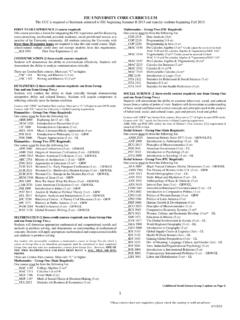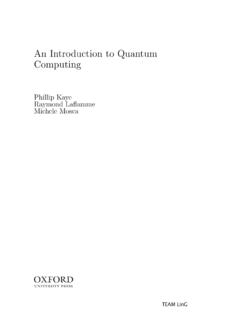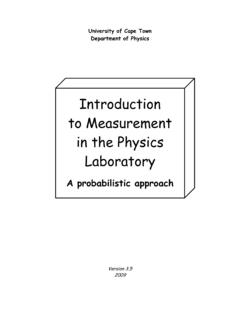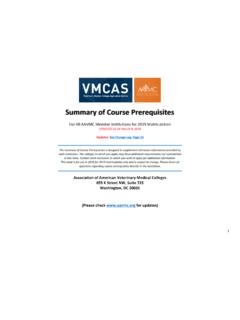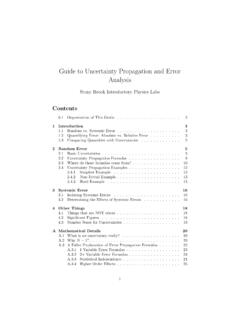Transcription of Introduction to Renormalization
1 Introduction to Renormalization with Applications in Condensed-Matter and High-Energy Physics Institute for Theoretical Physics, University of Cologne Lecture course, winter term 2017/2018. Michael M. Scherer January 26, 2021. Contents Contents 1. 1 Introduction 5. Aspects of the Renormalization group .. 6. Phase transitions .. 7. Critical phenomena .. 8. Perturbative quantum field theory .. 9. Renormalization -group based definition of QFTs .. 10. QFTs in the high-energy limit .. 11. 2 Phase transitions and critical phenomena 13. Ising model .. 13. Remarks on solutions of the Ising model in d = 1 and d = 2 .. 14. Symmetries of the Ising model .. 15. XY model and Heisenberg model .. 15. Universality and critical exponents .. 16. Scaling hypothesis for the free energy .. 17.
2 Derivation of power laws from scaling hypothesis .. 18. First attempt to calculate critical exponents .. 19. Correlations and hyperscaling .. 20. Ginzburg-Landau-Wilson theory .. 22. Functional integral representation of the partition function .. 22. Saddle-point approximation (SPA) .. 27. Critical exponents in saddle-point approximation .. 28. Kosterlitz-Thouless phase transition .. 29. XY model in two dimensions .. 29. Limiting cases at low and high temperatures .. 30. 3 Wilson's Renormalization group 31. General strategy .. 31. Momentum-shell transformation .. 34. Perturbation theory .. 35. Combinations in eq. ( ) that contribute in eq. ( ) .. 36. 1. Contents Determination of fixed-point coupling below four dimensions .. 39. Epsilon expansion and Wilson-Fisher fixed point.
3 41. Summary and comparison to experiment .. 44. Excursion: Relations to QFTs in high-energy physics .. 45. Landau-pole singularity and the triviality problem .. 47. Fine-tuning and the hierarchy problem .. 49. 4 Functional methods in quantum field theory 51. Introductory remarks .. 51. Generating functional .. 52. Correlation functions .. 52. Schwinger functional .. 54. Effective action .. 54. Perturbative Renormalization .. 57. Divergencies in perturbation theory .. 57. Removal of divergencies .. 60. Divergencies in perturbation theory: general analysis .. 63. Classification of perturbatively renormalizable theories .. 66. 5 Functional Renormalization group 69. Effective average action .. 69. The regulator term .. 70. Wetterich equation .. 71. Some properties of the Wetterich equation.
4 73. Method of truncations .. 74. Example: Local potential approximation and for a scalar field .. 75. Functional RG fixed points and the stability matrix .. 77. Example: critical exponents for scalar field theories .. 79. Ultraviolet completion of quantum field theories .. 81. Preliminaries .. 81. Asymptotic safety scenario (Weinberg 1976, Gell-Mann-Low 1954) .. 83. Candidate theories for asymptotic safety .. 86. A Remark on generating functional 89. Connected and disconnected Green's functions .. 89. Example: two-point function .. 91. B Divergencies beyond 1-loop 93. Recap: Renormalized action and 1-loop divergencies .. 94. Divergencies beyond 1-loop .. 96. Callan-Symanzik equations .. 97. Inductive proof of perturbative renormalizability (idea) .. 99. 2. Recommended literature 1.
5 I. Herbut, A Modern Approach to Critical Phenomena, Cambridge University Press. No-frills Introduction to critical phenomena and basics of the Renormalization group a la Wilson. Excellent first read to become acquainted with the physics and concepts. The start of this lecture follows this presentation, my chapters on the Ginzburg-Landau-Wilson theory and Wilson's RG. J. Zinn-Justin, Quantum Field Theory and Critical Phenomena, Oxford University Press (2nd edition). 1000+ pages of quantum field theory and statistical mechanics for enthusiasts with a lot of details, background and also explicit calculations. Also contains also some more formal and mathematical aspects. Can also be considered as a general reference work. Does not contain functional Renormalization . My chapter on the functional integral approach to QFT is a compilation of Chaps.
6 5,6, 7 & 9 of this tome. H. Gies, Introduction to the functional RG and applications to gauge theories, e- Print:hep-ph/0611146. Sections 1 and 2 give a smooth and straightforward Introduction to the functional RG formalism and a very nice instructive example for its application (the euclidean anharmonic oscillator). Inspired parts of my chapter on functional RG. Peskin and Schroeder, An Introduction to Quantum Field Theory, Addison-Wesley. The introductory QFT textbook for particle physicists. After a canonical Introduction to relativistic QFT in part I, the second part deals with functional integrals. Also contains a pretty nice chapter on critical phenomena which provides a complementary point of view. No functional RG. Further useful reads J. Cardy, Scaling and Renormalization in Statistical Physics, Cambridge Lecture Notes in Physics.
7 P. Kopietz, L. Bartosch, F. Schu tz, Introduction to the Functional Renormalization Group, Lecture Notes in Physics 798. 3. Contents M. Salmhofer, Renormalization . An Introduction . Springer, Berlin 1998, ISBN 3540646663. 4. Chapter 1. Introduction Quantum field theory provides a framework for the description of all fundamental interac- tions (strong, weak, electromagnetic, maybe gravity), phase transitions in particle physics, statistical mechanics and condensed-matter physics: Quantum field theory is the framework for the discussion of systems with a large/infinite number of coupled degrees of freedom. In quantum field theory and statistical mechanics Renormalization is required to treat infini- ties which appear in calculated quantities, typically induced by effects of self-interactions.
8 Moreover, even when no infinities occur in loop diagrams in QFT, Renormalization of masses and fields appearing in the Lagrangian is needed. Renormalization is a procedure to adjust the theoretical parameters describing a system in such a way as not to change the measurable properties on the length of time scales of interest. Generally speaking, in quantum or statistical field theory, a system at one scale is described by a set of different parameters (particle masses, couplings, interactions,..). The Renormalization group (RG) then describes how these parameters are changed when the system is considered at a different scale, the couplings of a system are running couplings, running with the scale. A variation of the scale loosely corresponds to changing the magnifying power of an appropriate microscope for viewing the system.
9 The Renormalization group refers to a mathematical procedure that facilitates the system- atic study of the changes of a physical system when viewed at different length or energy scales. Upon changing the scale, it might turn out that a particular description of a system in terms of a chosen Lagrangian becomes inappropriate and new degrees of freedom arise. This can also be assessed by the RG. 5. 1. Introduction In the following, I will first discuss some of the aspects of the RG to give a rough overview. These different aspects will then be worked out in more detail during the lecture. Aspects of the Renormalization group phase transitions and critical phenomena in: statistical mechanics (liquid-vapor transitions, ferromagnetic transitions,..). condensed-matter/solid-state physics (superfluid/superconducting transitions.)
10 Quantum chormodynamics (chiral symmetry-breaking, confinement-defconfinement transition,..). Standard-Model-Higgs sector perturbative quantum field theory divergencies and their removal predictivity of QFTs classification of (perturbatively) renormalizable QFTs quantum field theories in the high-energy limit triviality problem non-perturbatively renormalizable QFTs UV completion asymptotic freedom/safety Renormalization -group based definitions of quantum field theories 6. liquid-gas (1st order) theory space order parameter Phase transitions S +. Renormalization -group methods are relevant to a large diversity of fields many (apparently) different implementations sometimes hard to access temperature Functional RG provides unified formulation. h m> 0. Phase transitions m 0 m= 0.
